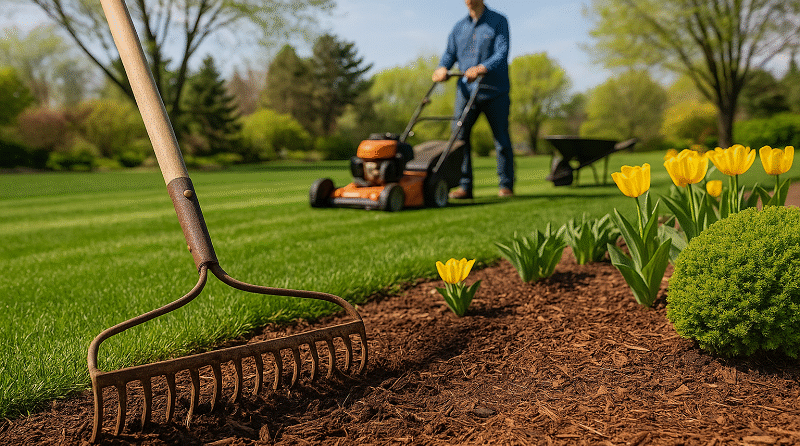As winter fades, your yard is ready for a fresh start. Spring is the perfect time to rejuvenate your landscape, boost curb appeal, and set the stage for a healthy, vibrant lawn all season long. Whether you’re a homeowner or property manager, this spring landscaping checklist will help you prepare your yard efficiently and beautifully.
Why Spring Landscaping Matters
Spring is nature’s reset button. Taking early action ensures:
- Healthy root development
- Strong grass growth
- Prevention of weeds and pests
- Increased property value
- Improved outdoor enjoyment
By starting with the right seasonal landscaping tips, you’ll save time, effort, and money later.
Your Essential Spring Landscaping Checklist
1. Clean Up Debris
Remove fallen branches, leaves, and winter mulch. Clear flower beds, lawn, and walkways to help soil breathe and absorb nutrients.
Pro Tip: Use a leaf blower or rake for efficient yard cleanup.
2. Inspect for Damage
Look for cracked walkways, broken irrigation lines, winter burn on shrubs, or lawn compaction. Make repairs early to prevent costly fixes later.
3. Test and Enrich Your Soil
Spring soil tests reveal nutrient deficiencies. Add compost, organic matter, or fertilizer based on results to ensure healthy plant growth.
4. Prune Shrubs and Trees
Cut back dead branches and shape overgrown trees or shrubs. This encourages new growth and improves overall structure. Tree cutting and pruning during early spring helps set the foundation for healthy growth throughout the year.
5. Aerate the Lawn
Aeration reduces soil compaction and allows oxygen, water, and fertilizer to reach the roots.
Ideal Timing: Late March to mid-May depending on your region. Pairing core aeration with overseeding can significantly improve lawn density and color.
6. Apply Pre-Emergent Weed Control
Get ahead of weeds before they sprout. Use a pre-emergent herbicide or organic alternative to stop weed seeds from germinating.
7. Mow Smartly
Sharpen your mower blades and raise the deck height. Never cut more than 1/3 of the grass height at once. Regular lawn mowing and trimming promotes uniform growth and prevents stress on the turf.
8. Edge Garden Beds and Paths
Well-defined edges create a polished look and keep mulch, soil, and grass in their place. Use a manual or power edger for best results.
9. Mulch Flower Beds
Add 2–3 inches of mulch around plants to retain moisture, suppress weeds, and regulate soil temperature.
Bonus: Use dyed mulch for extra visual pop. Fresh rock and mulch bed installation not only improves aesthetics but also supports soil health and weed control.
10. Plant New Flowers or Shrubs
Spring is ideal for planting perennials, shrubs, and ornamental trees. Choose native species for better adaptability and lower maintenance.
11. Inspect and Activate Irrigation Systems
Check for leaks or clogged sprinkler heads. Set timers for early morning watering to reduce evaporation.
12. Consider Hardscaping Enhancements
Plan patio upgrades, install pathways, or add outdoor lighting to boost functionality and value.
Top Plants to Add This Spring
| Flower | Bloom Time | Sunlight | Colors |
| Tulips | Early Spring | Full Sun | Red, Yellow, Pink |
| Daffodils | Early-Mid Spring | Full Sun | White, Yellow |
| Daylilies | Mid-Late Spring | Partial Sun | Orange, Red |
| Hostas | Late Spring | Shade | Green, White |
Recommended Tools for Spring Landscaping
- Lawn mower with adjustable blade
- Garden rake & leaf blower
- Aerator (manual or powered)
- Soil test kit
- Pruning shears
- Edging tool
- Wheelbarrow
- Irrigation tester
Local Tip
By following this spring lawn care and landscaping checklist, you’ll be ready to enjoy a lush, beautiful yard all season. Regular tasks like lawn mowing, tree pruning, and mulch installation play a major role in creating and maintaining a vibrant outdoor space.
Ready to Transform Your Yard?
By following this spring lawn care and landscaping checklist, you’ll be ready to enjoy a lush, beautiful yard all season. If you’re short on time or need professional help, consider hiring a local landscaping expert for lawn mowing, sod installation, tree trimming, or full-service seasonal cleanup.
FAQs
Q1: When should I start spring landscaping?
A: Start as soon as the soil is no longer frozen and temperatures stay consistently above freezing—typically late March to early May depending on your region.
Q2: What’s the most important task in spring yard prep?
A: Lawn aeration and debris cleanup are key to reviving your yard after winter and preparing it for healthy growth.
Q3: Is mulch necessary for flower beds?
A: Yes, applying 2–3 inches of mulch helps retain moisture, regulate soil temperature, and suppress weeds.
Q4: Should I fertilize before or after mowing?
A: Fertilize after your first spring mowing to give nutrients direct access to the soil and roots.
Q5: How often should I mow my lawn in spring?
A: Once a week is ideal, but it depends on how fast your grass grows—never cut more than one-third of the blade height at a time.


